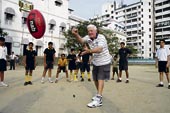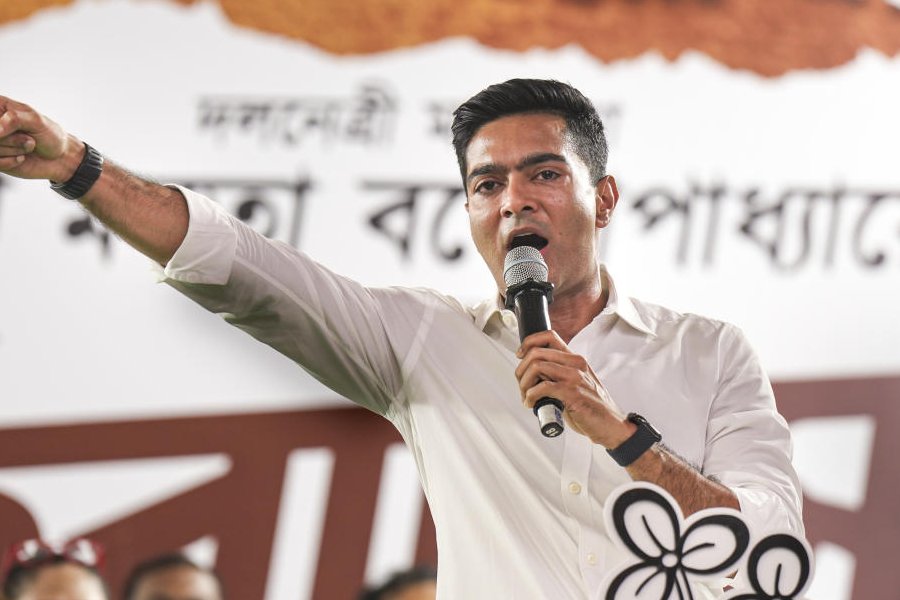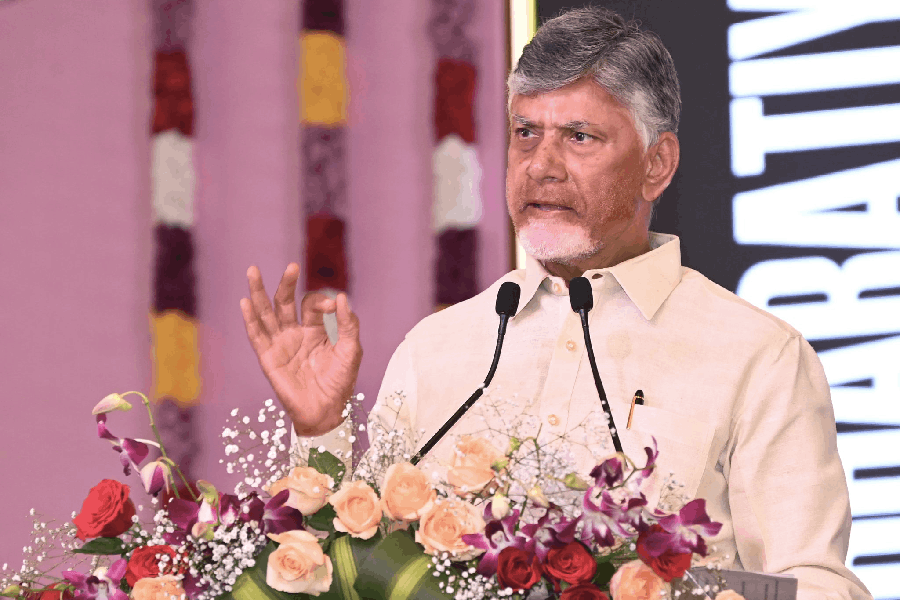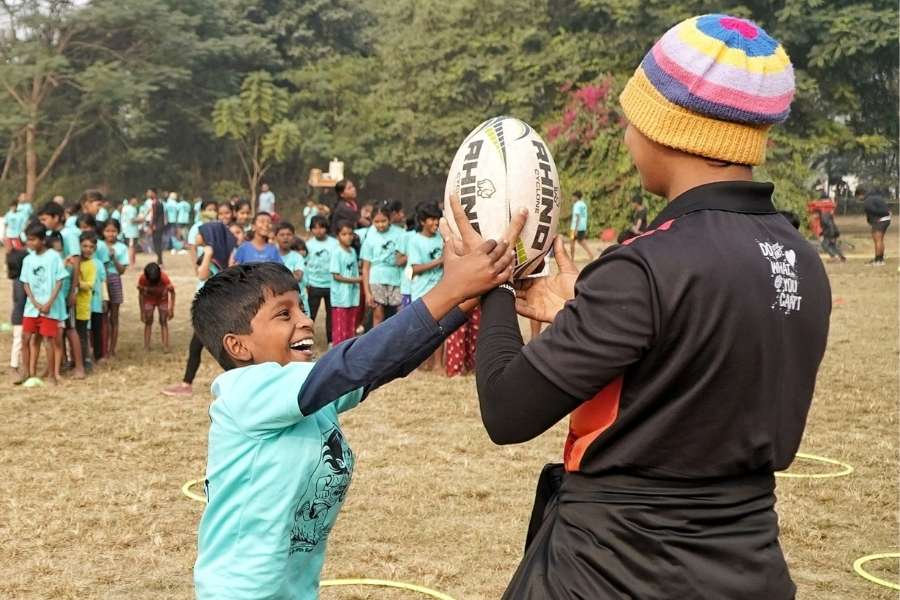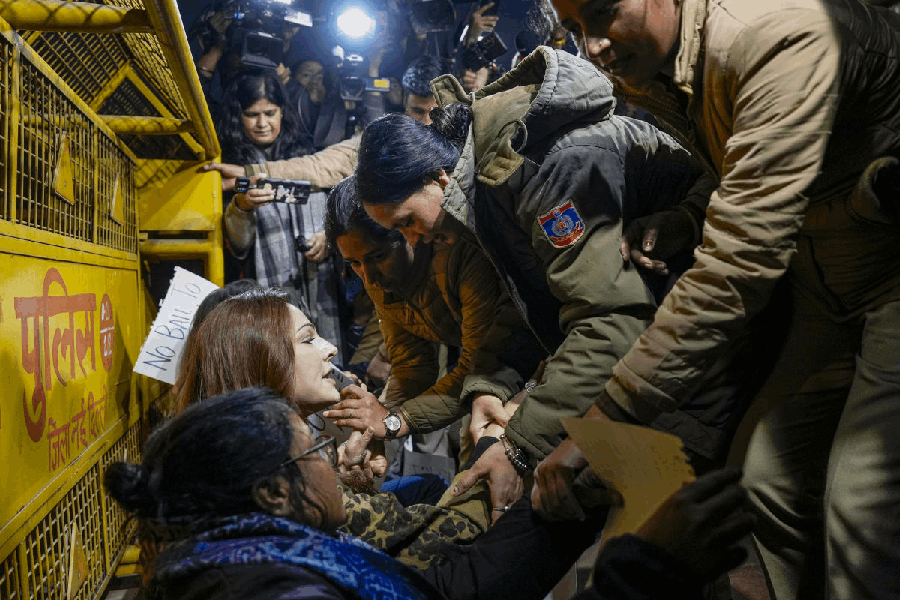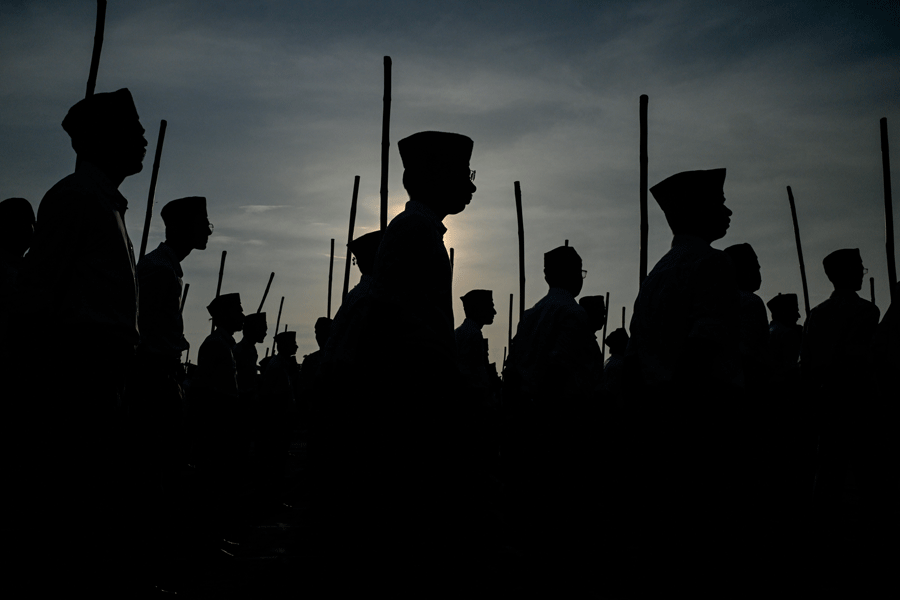 |
| Brian Dixon demonstrates a throw to students of La Martiniere for Boys on Wednesday. Picture by Bishwarup Dutta |
Australian Football is going to be a household name in the city if Brian Dixon of the Australian Football League has his way. At La Martiniere School for Boys for a demonstration of the game, he was delighted with the response from the students. “At least 10 kids show good potential,” he said.
For those unfamiliar with the term, Australian Football originated in the aboriginal game of “mangrook”, apparently using possum skin stuffed with coal for a ball. In 1840, Tom Wills, an Australian cricketer, came back from Rugby, a public school in England, and decided that Australia needed its own game. So he combined the principles of mangrook, soccer and football and came up with the concept of Australian Football. The first match was played in 1858.
Somewhat similar to rugby (the ball is similar to a rugby ball, only smaller), Australian Football is played with two teams of 11 players each in games divided into four quarters of 20 minutes. The idea is to gain possession of the ball, then run, kick and handball it towards the goals. But players cannot run with the ball for more than a distance of 15 metres. Tackling an opponent is allowed, so long as it is done below the shoulders and above the knees.
Initially a game to keep cricketers fit during the non-cricketing season, Australian Football now commands popularity in its own right. Dixon was crucial to the setting up of the branch of the league in South Africa in 2001. He said: “ Starting with 30 primary schoolkids, we now have 3,000 players in 15 leagues.”
On a balmy afternoon, Dixon’s enthusiasm belied his 70-odd years as he explained the game to the students of La Martiniere. After an audio-visual demonstration, he headed to the playground where dividing the students into two teams — those with and without shirts — a practice session of rudimentary Australian Football followed. After a hot and dusty session, Dixon remarked: “They are new to the game but they love it. It is the same everywhere; you make it available to them, they’ll play it.” Why India? “The US and UK play it. After China, India is the largest country in the east. There is no reason why it should not,” he replied.
A former minister of youth, sport and recreation in the Victorian Government, Australia, Dixon has also played Australian Football at the highest level, being selected the Best Player in 1965. He is now the chairman of the Australian league in South Africa. As a part of the league and Football Victoria’s initiative to spread the game to the rest of the world, the body has an Indian chapter of Australian Football in the pipeline. A visit to other schools in Calcutta, including St James School and Calcutta International School, is on the cards in the next few days. Dixon has also approached Calcutta University, which had “responded enthusiastically”.
Dixon, who toured China and Argentina before coming here, added: “We are looking at four teams from Calcutta, each comprising three categories of under-13, under-16 and over. So we are looking at 12 teams, which we hope to make a part of the International Tournament planned for September 2008.”
The league will supply the gear, including footballs and goal posts to players here. There are also plans of sending two people from India on a scholarship to Australia where they will be trained in the game, so that they can teach it back in India. In the city till November 18, Dixon is headed to Manila, where he will participate in the Congress of the Asiania Sports For All Association.
Romila Saha
Happenings here ’n’ there
Corporate agenda
 |
| Hands-on: Flaunting pretty tattoos, kids at Crossword spent a good part of Children’s Day admiring the bright designs on their hands. Picture by Bishwarup Dutta |
On November 6, an inter-college debate was organised by Hindustan Paper Corporation Limited as part of its week-long programme on “vigilance awareness”. The topic of the debate was “Only a Transparent and Ethical Organisation can be Vibrant and Successful”.
Seven colleges participated. Gitanjali Mukherjee of Loreto College was adjudged the best speaker while the runner-up prize went to Shawan Sen of St Xavier’s College, which also won the best team trophy. The company’s vigilance awareness programme was aimed to evolve a corporate culture of transparency and openness commensurate with the social expectations of the organisation.
Building skills
A mixed bag of fun and learning for children and grown-ups will be on offer at Birla Industrial & Technological Museum, from November 17 to 20. Titled Harek Rokom Ba (which means a mix of everything), the four-day event, focussing on vocational education in school curriculum, is part of Bal Vividha, an annual fair held in Mumbai.
It is for the first time that the fair is coming to Calcutta. Day One will have a colloquium on “Another Mainstream: Vocationally Oriented Curriculum”.
Screenings of children’s films, plays, magic shows, dance programmes, acrobatics and puppet shows are some of the other events. Designed for children studying in class V and above, the fair will have 25 interactive corners where the kids can try their hand at new things.
Representatives from vocational training organisations will be present to counsel about the various vocational options available to students after Class X and even for Class X dropouts. Teachers and parents can take part in workshops on child rights, good parenting, child health and nutrition, and on subjects in the Madhyamik curriculum.
Synergy seminar
The Institute of Engineering and Management in Salt Lake hosted a seminar on the symbiotic relationship between industry and institutes on November 11. The seminar was attended by dignitaries from various fields. CPM secretary Biman Basu unveiled a Bengali learning CD for adults, developed jointly by the IEM and Tata Consultancy Services (TCS), to address illiteracy in the state. “TCS has done a similar project in Telugu where it was found that if a person is exposed to this CD for 24 hours he or she can read at least 80 per cent of a newspaper,” said Satyajit Chakrabarti, director of the institute.
Talking about industry-institute partnership, Basu said: “In my student days, youngsters who studied instrumentation had no option but to take up other courses to make themselves employable. Hence, it necessary to decide on courses which will help meet industry expectations.”
Ratikanta Basu, IAS and former director general of Doordarshan, who inaugurated the seminar, gave away the IEM Business Executive Awards to Siddhartha Mukherjee, vice-president, Cognizant Technology Solutions, and to Ramesh Babu of Infosys, Bangalore.

